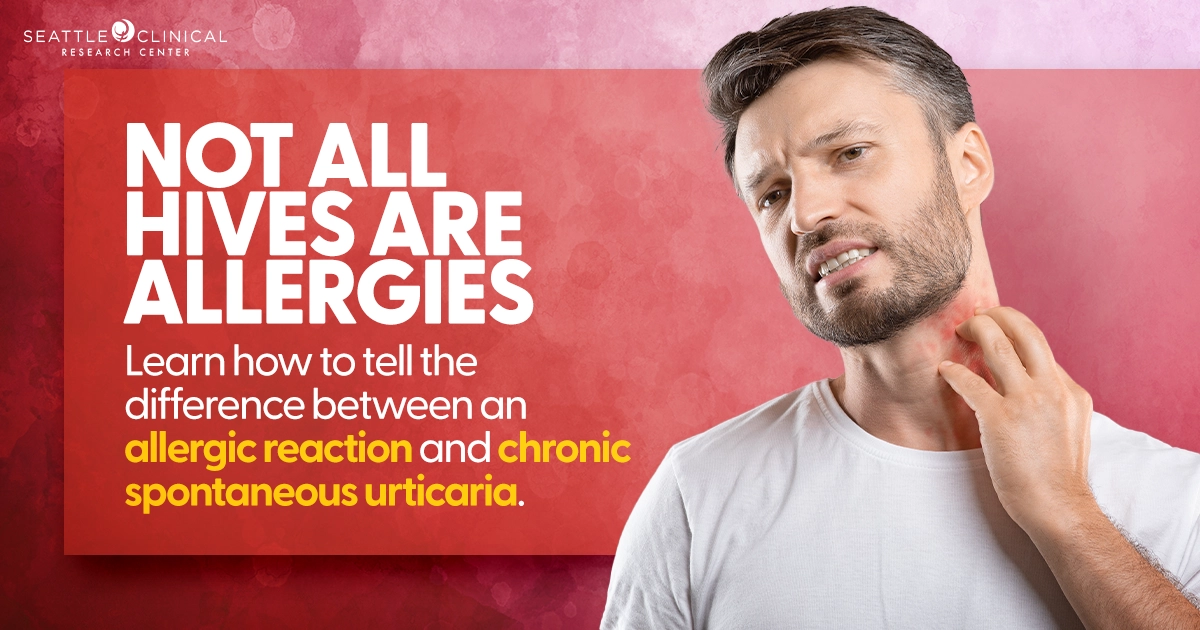Breaking out in hives can be frustrating, uncomfortable, and even alarming—especially when you don’t know why it’s happening. Most people assume hives are caused by an allergic reaction, but that’s not always the case. In fact, some persistent hives could be a sign of a condition called chronic spontaneous urticaria (CSU). So, how can you tell the difference between an allergic reaction and CSU? Read more below to break down the differences.
What Is CSU?
Chronic spontaneous urticaria (CSU) is a condition marked by recurring hives, swelling (angioedema), or both that last for six weeks or longer. The keyword here is spontaneous—these hives appear without an identifiable trigger and can occur daily or off and on for months or even years.
Unlike a typical allergic reaction, CSU is not caused by foods, medications, or environmental allergens. Instead, it is believed to be a complex condition linked to the immune system, activation of mast cells and may be associated with autoimmune conditions. The exact cause though is not always known.
What Does an Allergic Reaction Look Like?
Allergic reactions are caused by the immune system responding abnormally to a specific trigger, often a protein—eg: peanuts, shellfish, pet dander, or pollen. Symptoms usually show up shortly after exposure and may include:
- Hives or rash
- Itchy or watery eyes
- Swelling (often around the face or throat)
- Sneezing or nasal congestion
- Difficulty breathing in severe cases (anaphylaxis)
These reactions typically improve once the allergen is removed and may be treated with antihistamines or epinephrine in emergencies.
CSU vs. Allergic Reactions: How to Tell the Difference
Not sure if your hives are caused by allergies or something else? Here are the key differences between chronic spontaneous urticariaand a typical allergic reaction:
- Duration: Allergic hives usually go away within a few hours to a few days. CSU, on the other hand, lasts for 6 weeks or longer and may come and go without warning.
- Triggers: Allergic reactions are typically caused by specific substances like certain foods, medications, insect stings, or pollen. CSU doesn’t have an obvious or consistent trigger and often occurs without any known cause.
- Onset: Allergic reactions usually happen shortly after exposure to an allergen. CSU can start at any time, with no clear connection to an event or substance.
- Symptoms: Both conditions can involve hives and itching, but allergic reactions may also include sneezing, watery eyes, swelling around the lips or eyes, or breathing issues. CSU is typically limited to hives and sometimes deeper swelling (angioedema).
- Response to Avoidance: Allergic hives generally go away once the allergen is avoided. With CSU, avoiding triggers doesn’t usually help, because there’s often no specific trigger to avoid.
- Underlying Cause: Allergic reactions involve the immune system responding to a known allergen. CSU is often idiopathic (no clear cause) or may be linked to autoimmune activity.

CSU Research
If you’ve been struggling with itchy, unexplained hives, don’t guess—get answers. Understanding the difference between CSU and allergic reactions is the first step toward finding the right treatment and getting relief.
If you think you may be living with CSU, you might qualify for clinical research studies exploring potential new options. Check out local enrolling studies to see if participating is right for you.


